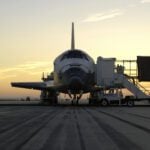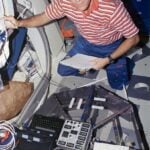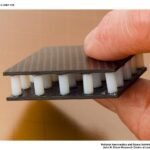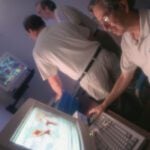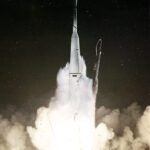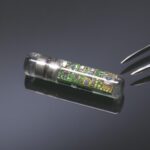Space Technology Hall of Fame Inductees
The Space Technology Hall of Fame® comprises many extraordinary innovations — all derived from or significantly improved by space research or exploration. To nominate a technology, please visit our Nominate a Technology page to learn more about the Space Technology Hall of Fame® selection criteria.
Search Filters:
For decades, ground and polished glass had been the preferred lens in the eyeglass industry. That changed in 1972 when the Food and Drug Administration issued a regulation that all sunglasses and prescription lenses must be shatter-resistant. The main disadvantage to glass is its brittleness, so eyeglass manufacturers turned to plastics. Plastic lenses had many…
Read MoreIn the late 1960s, NASA’s Johnson Space Center went searching for a lightweight, non-combustible fabric durable and strong enough to protect the astronauts in an alien, zero-gravity environment. One American company, Chemical Fabrics, a specialty weaver and coater, was already experimenting with advanced composites. ChemFab wove the specially designed Owens Corning Fiberglass yarn into a…
Read MoreNASA scientists, in order to conduct a thorough study of the Moon’s soil, needed samples from both the lunar surface and subsurface. Digging into the hard lunar surface layer demanded a lightweight, compact power drill capable of drilling 10 feet below the surface. To top those requirements, the drill also needed its own independent power…
Read MoreIn the 1960s, NASA’s Langley Research Center initiated an extensive research program to develop a method to reduce the incidence of aircraft tire hydroplaning, a condition that occurs during rainstorms when tires rolling or sliding along water-covered pavement are lifted away from the surface by the action of water pressure. Aircraft tire hydroplaning was considered…
Read MoreIn the early days of NASA’s space research, there was concern over problems of temperature control of non-rotating satellites. The side facing the sun would build up excessive heat, and the opposite side would become very cold, thus a serious threat to the survival of electronic and other spacecraft systems. To address the problem, Los…
Read MoreDuring the 1960s, research on protective coating materials at NASA’s Lewis Research Center demonstrated that a class of polymers known as condensation polymides could be fabricated into lightweight fiber reinforced plastics. These materials were capable of withstanding temperatures up to 6000 F for thousands of hours but were not initially easily utilized. Lewis researchers, led…
Read MoreSudden cardiac death (SCD) takes the lives of nearly a half million Americans each year. Some 80 percent die before medical help arrives and those who survive have faced a two-year heart attack recurrence rate as high as 55 percent. The Automatic Implantable Cardiovertor Defibrillator (AICD) gave new hope to these victims by lowering the…
Read MoreIn 1978, the Science and Technology Laboratory (STL), formerly the Earth Resources Laboratory (ERL), at NASA’s Stennis Space Center (SSC), began its program of image and geographical information system processing of satellite and airplane data. This data-gathering process is known as remote sensing. It is technology that enables meteorologists, scientists, climatologists, and others to monitor…
Read MoreThe Automatic Picture Transmission (APT) was first transmitted in December 1963 from TIROS VII (Television Infrared Observation Satellite) as an experiment. The purpose was to demonstrate the feasibility of sending images of cloud formations from the weather satellite direct to the user, anywhere on the face of the Earth. The only requirement was that the…
Read MoreThe physiological monitoring instrumentation was developed to transmit astronaut physiological data to ground stations for monitoring and analysis. This family of technologies opened a whole new world of remote biological monitoring on Earth. Patients in locations away from a medical facility or in transit can be monitored and assisted. For example, heart readings can be…
Read More


